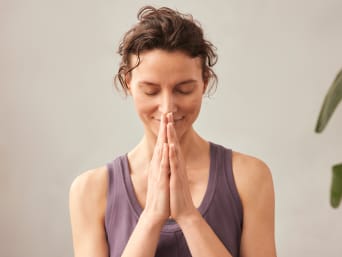
Yoga: History and important yoga terms
Yoga originated in India many thousands of years ago as one of six worldviews. The goal of yoga and a cornerstone of yoga philosophy is to create unity between body, mind, and spirit. To achieve this harmony, yoga includes exercises for more mental and physical balance as well as methods for self-discovery. To learn more about the origins of yoga, we have summarised the history of yoga in this article. In addition, we give you an overview of the most important yoga terms.

Table of contents
Yoga: History & Origin
The four paths of yoga
Overview of important yoga terms
Yoga history & origins: Where does yoga come from?
The history of yoga is very interesting and long. Even thousands of years ago people felt the need for more inner peace and physical fitness.
To give you an overview, we will show you important stages and developments in the history of yoga:
Yoga was first mentioned over 3,500 years ago in the ancient Indian scriptures: the Vedas. However, it can be assumed that it was practised long before it was first mentioned in writing.
Yoga philosophy continued to develop over the millennia until an Indian scholar named Patanjali summarised the most important teachings. The exact dates of Patanjali’s life are unknown. It is thought that he lived between the 2nd century BC and the 4th century AD. He is considered the father of yoga and his 194 verses (Yoga Sutras) are still the basis of modern yoga.
It was only between the 6th and 15th centuries AD that the classical forms of Hatha Yoga developed, i.e. the sequences of physical exercises as we know them today.
When the West discovered India in the 14th century, yoga was attributed to the Hindu faith and therefore considered “pagan”. The practice of yoga was forbidden during the Christian missionary era and the English colonial period, i.e. until the end of the 19th
century.

A rethink did not take place until the end of the 19th century. In 1893, Swami Vivekananda appeared before the American Parliament of Religions and wared the Western world to yoga for the first time. Through his lectures in the USA and England, he made many people aware of yoga and its health benefits. That is why he is considered one of the most important yoga masters in modern times.
In the 20th and 21st centuries, yoga spread in waves all over the world and new styles emerged. In December 2014, the United Nations declared 21 June the International Day of Yoga following an initiative by Indian Prime Minister Narendra Modi.
Yoga has had an eventful and interesting history through the millennia. However, one of the most important highlights is the writing of the Yoga Sutras by Patanjali. His yoga philosophy still shapes the way we practice yoga today. Below, you will find a summary of the most important thoughts of Patanjali’s yoga philosophy.
The yoga philosophy: Overview of the ways of yoga
Yoga is not just a sport or a sequence of exercises to reduce stress – yoga can be a way of life. Modern western yoga is strongly oriented towards Hatha Yoga, which strives for unity and harmony of the mind with the body and the soul. Hatha Yoga is part of the Raja Yoga path and refers mainly to physical exercises, breathing and relaxation techniques that we do in yoga classes. However, Hatha Yoga is one of the newest paths. Originally, Patanjali divided the yoga philosophy and practices into four paths:
Bhakti Yoga is about devotion to God and/or nature. Bhakti Yoga, like all yoga philosophies, strives for self-realization. Yogis can achieve bliss through a spiritual orientation and a complete openness to the divine.
Karma yoga is probably the best-known path to unity and enlightenment. It is about acting selflessly to be in harmony with one’s own mind and soul. In doing so, yogis try to renounce egoistic and materialistic motives and achieve salvation through selfless deeds.
Jnana Yoga is the yoga of knowledge. It is about knowledge, wisdom, and philosophy. Yogis who follow the path of Jnana Yoga try to understand the deeper meaning behind everything and look at life in a philosophical way.
Raja Yoga is also called the “royal path of yoga”. Yogis go through an 8-step path consisting of the attitude towards yourself and your environment, the exercises, concentration, and meditation. Raja Yoga is meant to help you develop and master your mind.

An overview of important yoga terms: From Asana to Namasté
Since yoga originated in India, experienced yogis use the traditional yoga words found in the ancient scriptures. To give you an overview, we explain the most important yoga terms here:
Asana: The exercises and positions of yoga are called asanas. The term is mainly used for resting postures.
Chakra: A chakra is an energy centre. There are 7 main chakras located along our spine. Through yoga, these centres are energised to release blockages and free up energy.
Karana: A sequence of yoga exercises is called a Karana. Today we often refer to it as yoga flow.
Mantra: A mantra is a chant or sound that a teacher gives to their student. Mantras are repeated in a certain rhythm to set the atmosphere vibrating and thus move invigorating and healing energies.
Namasté: “The divine in me greets the divine in you” is the Indian greeting at the beginning and end of every yoga session. It is less about religion than about respect and recognition of the other person’s soul.
Om: It is the most important mantra and the original sound of the universe. When you chant this mantra, you bring yourself to the same vibration as the universe.
Prana: It is the life energy that flows through everybody. Yoga exercises help you to enrich prana and send it throughout your body.
Pranayama: This is what the breathing exercises in yoga are called. The breathing techniques of Hatha Yoga and all its types serve to direct the life force prana.
Samadhi: The state of oneness and the goal of yoga is samadhi. It is a state of absolute self-revelation and thus liberation.
With the help of this small list of yoga terms, you will be well equipped to master your first yoga practice. If you are still looking for the right yoga style for you, look at our overviews for relaxing yoga or for fitness-oriented yoga. You’re sure to find exactly the yoga style that suits you.
______________________________________________
Sources
[1] https://isha.sadhguru.org/yoga/new-to-yoga/types-of-yoga/
(accessed 05.10.2021)
Image sources
iStock.com/jacoblund
iStock.com/~UserGI15632746
iStock.com/oculo





